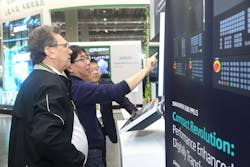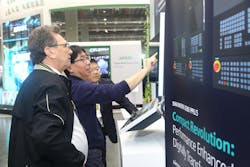AI Has a Path for Digitizing Traditional Machine Tooling
Adopting the slogan “Integrate to Innovate,” TIMTOS 2025 focused on three areas: AI & Robotics, Smart Manufacturing and Green Sustainability.
By a show of numbers, about 1,000 exhibitors, 6,100 booths and nearly 50,000 visitors, the event has an influence on strengthening collaboration among leading companies in the machine tool industry.
Siemens was among top-tier international exhibitors demonstrating cutting-edge capabilities at the smart manufacturing and machine tool exposition, which ran March 3-8, 2025, in Taipei, Taiwan.
Siemens has been an innovation partner to medium-sized companies in Taiwan for decades. This year, the German multinational made its presence known by promoting how integrated AI, automation and robotics solutions are taking the foreground in planning for next-generation manufacturing.
READ MORE: TIMTOS 2025: A Gateway to a Global Machine Tool Industry
Siemens supports more than 100 machine builders in Taiwan, said the company’s head of Machine Tool, Ben Tan, on a call with Machine Design ahead of the show. This presents a challenge, he said, as the sheer number of mid-size machine builders means that his company sees competition from other regions and countries.
“At TIMTOS we want to support our customers by not only helping transform small machinery businesses, but helping them accelerate,” he said. “We provide innovation not only for the machine builder but also for the machine customer, which means every CNC job shop.
Established International Competitiveness
The machine tool and machinery industry make up Taiwan’s third largest industry in terms of output value, after the semiconductor and panel industries. Taiwan, officially the Republic of China (ROC), generated $48 billion in local production and accounted for $34 billion in exports, according to the ITA (International Trade Administration). The top 10 leading machine tool producer countries are China, Germany, Japan, the United States, Italy, South Korea, Taiwan, Switzerland, Austria and Spain.
Supporting Seamless Interconnected Shop Floors
When customers develop digital twins (virtual representations of physical assets), said Tan, it speeds up the time required to deliver machines and reduce costs. This is because the digital twin allows the machine builder or CNC machine shop to simulate and test the machine in a virtual environment before it is physically built. The simulation can identify potential issues or improvements early on and avoid mistakes during the actual production process.
“The customer doesn’t need to really work with the physical world; they can really prepare and maybe do some simulation in the digital world,” said Tan. “The digital twin is really helpful for our customer to shorten the delivery time and also shorten time to market.”
Digital Twins Streamline Machine Design and Assembly for Builders
Digital twins enhance machine builders’ design departments, explained Tan. “They have a machine concept...and they will make the 3D drawing of the machine for the mechanical parts,” he explained. “In the traditional way, they will produce the parts and the machine body and do the assembly in the factory. But now, if the customer has a digital twin, the design department can output the 3D drawing to the digital twin tool.”
Digital twin technology allows engineers to assemble the digital machine in the digital world before the physical machine has been assembled in the production line. Another advantage at the design phase is that designers can verify “whether it is the right design or not,” Tan said, adding that simulation using a digital twin helps meet the requirements for the customer.
Introducing AI Integration via Adaptive Control Monitoring
Visitors to the Siemens booth could expect to learn about tangible ways to integrate advanced tooling technologies, such as ACM (adaptive control monitoring).
“The machine learns from the first cutting of the workpiece,” said Tan. “After learning, the controller will automatically optimize the process for the program and cutting conditions. Normally, we can reduce the machining time 15% to 20%, which means the customer can reduce the machining time, reduce the energy consumption and can increase the productivity for the CNC shop floor.”
This solution was discussed in detail during a keynote forum aimed at highlighting practical applications of cutting-edge capabilities and ensuring sustainable manufacturing. Christine Herbst-Kubitz, general manager, Siemens Taiwan Digital Industries, said during her keynote presentation that there are many ways an ACM software suite with machine learning functionality can be applied in metal-cutting operations, including milling, turning, grinding, gun drilling or gear hobbing. The software can optimize the workpiece in the network, she said.
For example, in CNC machines, machine learning is used to optimize the spindle load or increase productivity by learning how the spindle speed needs to adapt.
Herbst-Kubitz demonstrated how the tool could be used to optimize the machine’s feed rate in real-time. ACM can speed up the process when cutting conditions allow, or slow down when geometry, material hardness or tool condition demand caution, she explained.
About the Author

Rehana Begg
Editor-in-Chief, Machine Design
As Machine Design’s content lead, Rehana Begg is tasked with elevating the voice of the design and multi-disciplinary engineer in the face of digital transformation and engineering innovation. Begg has more than 24 years of editorial experience and has spent the past decade in the trenches of industrial manufacturing, focusing on new technologies, manufacturing innovation and business. Her B2B career has taken her from corporate boardrooms to plant floors and underground mining stopes, covering everything from automation & IIoT, robotics, mechanical design and additive manufacturing to plant operations, maintenance, reliability and continuous improvement. Begg holds an MBA, a Master of Journalism degree, and a BA (Hons.) in Political Science. She is committed to lifelong learning and feeds her passion for innovation in publishing, transparent science and clear communication by attending relevant conferences and seminars/workshops.
Follow Rehana Begg via the following social media handles:
X: @rehanabegg
LinkedIn: @rehanabegg and @MachineDesign

